He was twenty-two when he made the front page of the Star-Telegram for the first time after a high-speed chase by police officers. He was thirty-five when he made the front page of the Star-Telegram for the last time after a high-speed chase by police officers.
The thirteen years in between were filled with nickel-and-dime robberies, a string of murders (for revenue or revenge), and two of the most audacious robbery plots in the history of Fort Worth crime.
Gene Paul Norris was born in Oklahoma in 1921. Gene Paul had an older brother, Thomas Nathan (known as “Pete”), born in 1912. Baby brother would follow big brother from the playpen to the penitentiary.
In 1937 big brother Pete, then twenty-five, was sentenced to ninety-nine years in Huntsville for an armed robbery in which a person was fatally shot.
In the 1940 census baby brother Gene Paul listed his occupation as a grocery store checker.
But soon Gene Paul the grocery store checker became Gene Paul the grocery store robber: He began committing holdups. He needed money to finance a jailbreak to get his big brother out of prison.
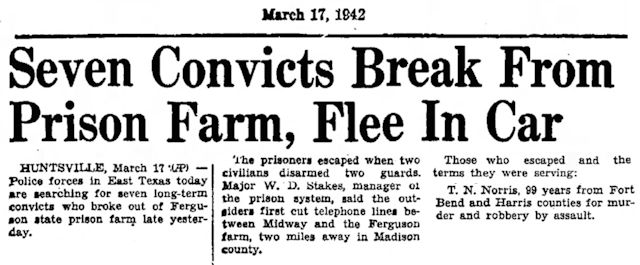 In March 1942 Gene Paul and an associate cut the telephone wires at the Ferguson prison farm at Huntsville and disarmed two guards, allowing brother Pete and six other long-term inmates to escape.
In March 1942 Gene Paul and an associate cut the telephone wires at the Ferguson prison farm at Huntsville and disarmed two guards, allowing brother Pete and six other long-term inmates to escape.
Reunited, during the next year the brothers Norris ran a lucrative hijacking ring. They also robbed participants of dice games, who were loath to report their loss to police. Victims also were afraid of retribution by the Norrises.
They robbed Sanger’s and Penney’s department stores and Worth and Buddie’s supermarkets. Gene Paul even bought a streetcar cafe on the North Side so that the Norris gang would have a safe place to eat.
During the Norris gang crime spree big brother Pete became infamous. R. G. Danner of the Dallas FBI office called him “public enemy no. 1.” FBI special agent W. G. Banister called him “one of the most dangerous gunmen in the United States.”
Then came February 23, 1943. Pete and Gene Paul and Gene Paul’s sixteen-year-old girlfriend were hiding at a ramshackle farmhouse near Kennedale.
Lawmen had learned that the Norrises were holed up at the farm and had it under surveillance. They knew the Norrises had two cars. Lawmen wanted to capture both brothers at once. Only when lawmen could see both cars at the farmhouse would they know that both Norrises were present. An FBI agent monitored the farm from a small airplane. When he saw both cars at the farmhouse he signaled lawmen on the ground.
Pete was plowing a field when he saw cars approaching. He ran to the farmhouse. The Norris brothers and Gene Paul’s girlfriend fled in one of their cars. Police pursued, firing at the fugitives as the cars sped down unpaved country roads.
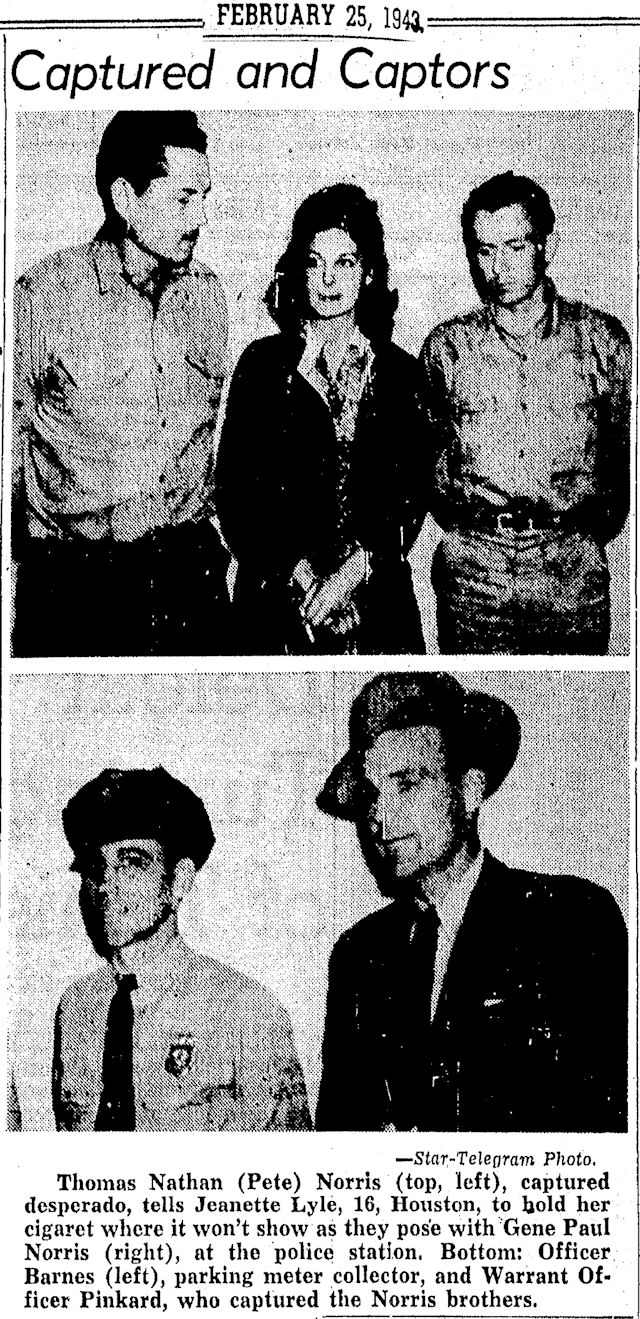 After twelve miles the Norris car overturned at a sharp curve. The two brothers, both armed, disappeared into thick brush but later surrendered to two Fort Worth policemen, one of them a parking meter collector! Note that as the Star-Telegram photographer was about to snap the top photo, Pete told Gene Paul’s girlfriend to put her cigarette out of view of the camera. She almost succeeded.
After twelve miles the Norris car overturned at a sharp curve. The two brothers, both armed, disappeared into thick brush but later surrendered to two Fort Worth policemen, one of them a parking meter collector! Note that as the Star-Telegram photographer was about to snap the top photo, Pete told Gene Paul’s girlfriend to put her cigarette out of view of the camera. She almost succeeded.
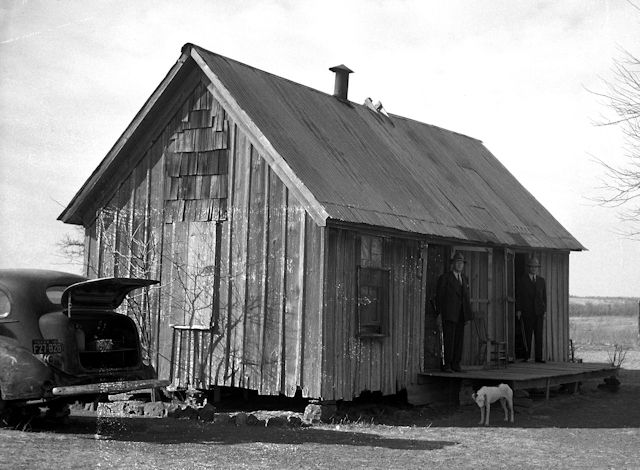
In the farmhouse police found food taken in a robbery of a Buddie’s grocery store and saddles and coins taken in a home burglary. (Photo from University of Texas at Arlington Star-Telegram Collection.)
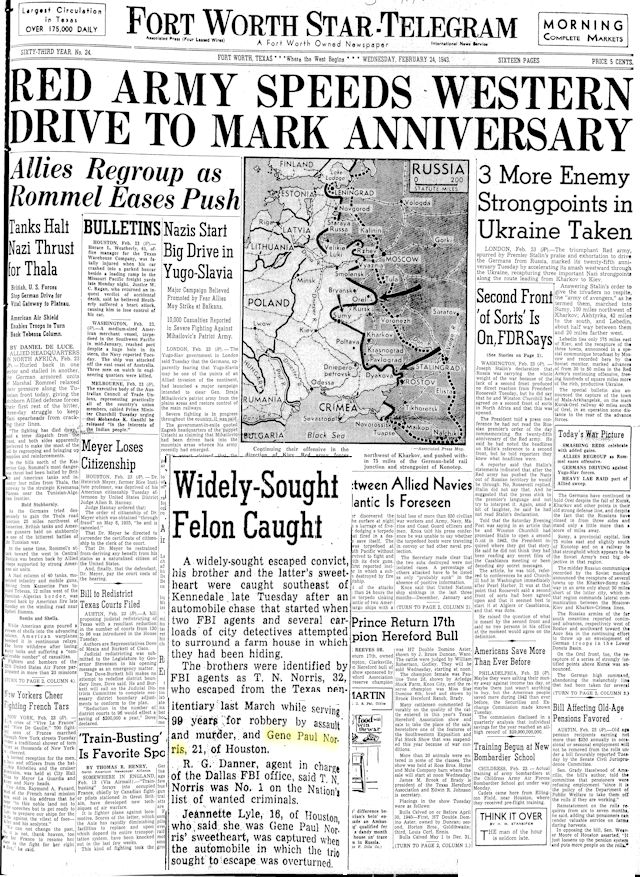 Pete was sent to Alcatraz, now facing 436 years in prison for various offenses.
Pete was sent to Alcatraz, now facing 436 years in prison for various offenses.
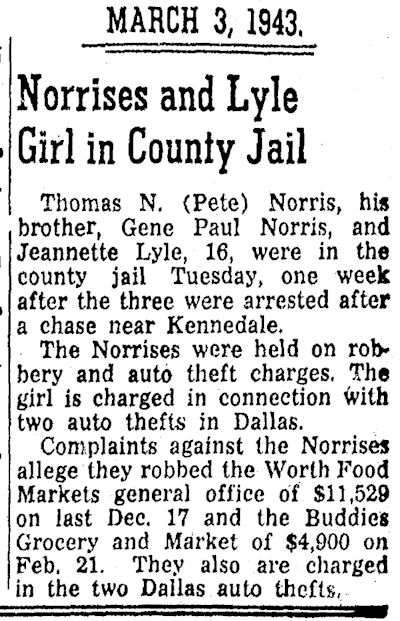 Likewise, Gene Paul was charged with a medley of crimes: evading the draft, stealing a car, robbing a grocery store, helping his brother escape from prison in 1942, robbing participants of a dice game in 1936, and impersonating an FBI agent in order to con a couple in Chicago out of $4,700.
Likewise, Gene Paul was charged with a medley of crimes: evading the draft, stealing a car, robbing a grocery store, helping his brother escape from prison in 1942, robbing participants of a dice game in 1936, and impersonating an FBI agent in order to con a couple in Chicago out of $4,700.
How proud Pete must have been of his baby brother.
Gene Paul was acquitted of some of those crimes. In May he was transferred from Tarrant County jail to Montgomery County jail in Conroe. He was scheduled to go on trial in Houston for draft evasion. He also faced trial for robberies in south Texas and an eight-year sentence for helping brother Pete break out of prison.
On May 30 a jailer opened Norris’s cell slightly to remove a waste basket. Norris pulled the jailer into the cell and locked the door. Norris and another inmate escaped from the jail and started out of town on foot. At a church they forced their way into a car occupied by a mother and her baby. As Norris and his associate started to drive the car away, the mother pulled the keys from the ignition. As Norris and the mother grappled for the keys, the baby began wailing. Norris and his associate vacated the car and proceeded on foot again. By the time they reached the lowlands of Cypress Creek they heard a bloodhound baying. The two men waded into Cypress Creek and stood nose deep in water to mask their scent, hoping they could avoid detection by the hound.
They couldn’t.
Back in custody, Norris claimed that the Montgomery County sheriff and the jailer had taken bribes from him to help the two inmates escape.
The sheriff and jailer were indicted, tried, and acquitted.
 Norris was sentenced to two years in prison.
Norris was sentenced to two years in prison.
 In 1945 Gene Paul Norris entered the Texas prison system with a sentence of thirteen years for committing robbery and for helping his brother escape from prison.
In 1945 Gene Paul Norris entered the Texas prison system with a sentence of thirteen years for committing robbery and for helping his brother escape from prison.
In 1949 he was released from prison on a conditional pardon and moved to Oklahoma. He also drifted down into Fort Worth, although he didn’t make the front page of the newspaper. As he and Pete had done during their spree of 1942-1943, Gene Paul mostly robbed other criminals who did not dare report their loss to police.
1952
Nonetheless, by 1952 Gene Paul Norris had built an impressive local resume of twenty-five arrests and six convictions.
And now he was ready for the big score, ready to step out of the shadow of his big brother.
Sam Brown Cresap, a Fort Worth car salesman, while in Mexico City had met Manuel Madareaga. Madareaga was one of three Cuban exiles plotting to buy weapons to overthrow Cuba’s President Fulgencio Batista. Cresap learned that Madareaga was seeking guns. Sensing a sucker, Cresap conceived the germ of a con. He told Madareaga that he could put Madareaga in touch with a gunrunner in Texas.
On October 2 Madareaga, accompanied by fellow Cubans Candido de la Torre and Jose Duarte and a valise stuffed with $50, $100, and $500 bills, rendezvoused in a cabana at the Western Hills Hotel on Camp Bowie Boulevard with Cresap and another American called “Johnny.”
Duarte and Cresap soon left the cabana.
Johnny stayed behind with De la Torre and Madareaga. Johnny dumped the contents of the valise onto the bed and counted the money: $248,000 ($2.2 million today).
About 3:30 a.m. Johnny told the two Cubans he heard a noise outside the door of the cabana. He went to the door to investigate. Madareaga later told authorities: Johnny “turned and waved a pistol as a man wearing a handkerchief and carrying a submachine gun came into the room.”
Johnny and the masked man forced the two Cubans to lie on the floor and bound their wrists and ankles with wire.
Then Johnny and the masked man and the $248,000 walked out the door.
The Cubans managed to phone police.
When Cresap and Duarte returned to the cabana, police arrested Cresap. The other three Americans remained at large.
The con game was played by four men:
- Sam Brown Cresap was the only one of the four men with no criminal record.
- Oklahoma bootlegger Orville Lindsay Chambless acted as go-between for the three Cubans and the four Americans.
- Floyd Allen Hill, known as “the gray scourge of the Southwest,” was the masked man with the Tommy gun.
- Gene Paul Norris was “Johnny.”
From a police mugbook the Cubans identified Chambless and Norris.
Chambless was arrested October 4 in Oklahoma City. Chambless implicated Hill and Norris in the robbery. Norris was arrested October 6 in Duncan, Oklahoma.
Floyd Allen Hill was arrested, broke out of jail, and was arrested again.
Acting on a tip, police found Hill’s share of the robbery money—$128,000—buried in a paraffin-sealed one-gallon Thermos bottle in a pasture.
Chambless was no-billed by a grand jury after the Cubans were unable to positively identify him in person.
Gene Paul Norris was acquitted by a jury despite the fact that at his trial the Cubans had identified him as “Johnny.” Six people—friends and relatives of Norris—testified that Norris had been in Duncan, Oklahoma at the time of the robbery.
Charges against Sam Brown Cresap were dropped.
Floyd Allen Hill was the only one of the four suspects in the Cuban caper to be convicted. He was sentenced to twenty years in prison.
The remainder of the money was never found.
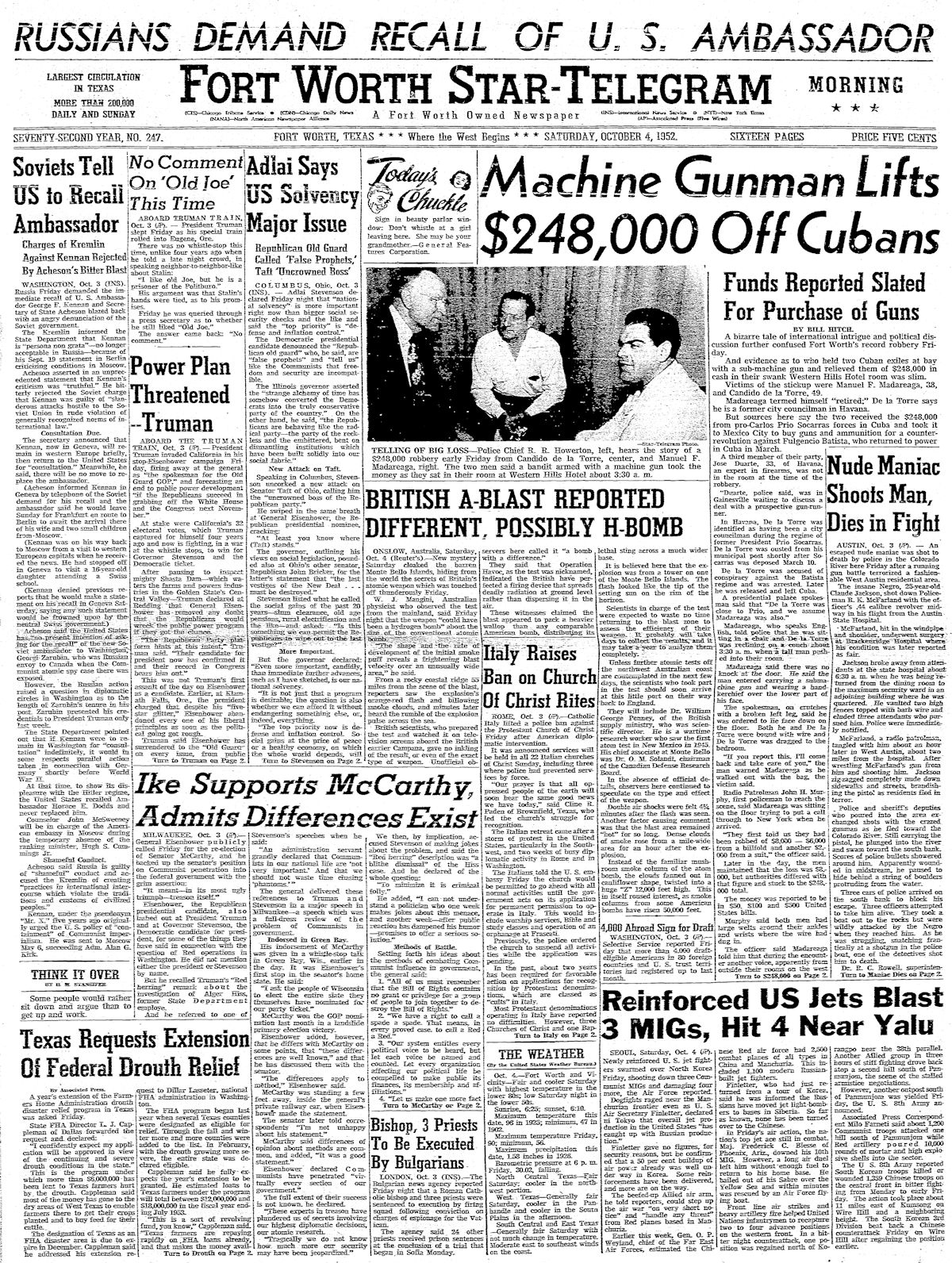 Even though Norris was acquitted in the Cuban caper, his 1949 conditional pardon was revoked, and he was sent to Huntsville to finish his sentence for committing robbery and helping brother Pete escape from prison.
Even though Norris was acquitted in the Cuban caper, his 1949 conditional pardon was revoked, and he was sent to Huntsville to finish his sentence for committing robbery and helping brother Pete escape from prison.
1955
By 1955 Gene Paul Norris was back on the streets of Fort Worth. And his favorite street was Jacksboro Highway.
After Gene Paul Norris hit town, on Jacksboro Highway and elsewhere, people began to disappear or die.
In May 1955 hardened hoodlums Cecil Green and Tincy Eggleston were free on bond as suspects in the 1953 murder of wealthy oilman William P. Clark. Police theorized that the two men were extorting money from their gangland associates to pay for the pair’s legal expenses in the Clark case.
On the night of May 2 Green and Eggleston were sitting in Green’s Cadillac at the By-Way Inn, a tavern on Jacksboro Highway. The tavern was closed. They may have been waiting for an extortion victim to bring a donation to their legal fund. Suddenly Green and Tincy saw a spotlight from a nearby parked car. Then muzzle flashes. Green was shot seven times. Eggleston said he emptied his pistol at the car as it sped away. Green died at a hospital. Eggleston suffered only minor cuts from flying car window glass.
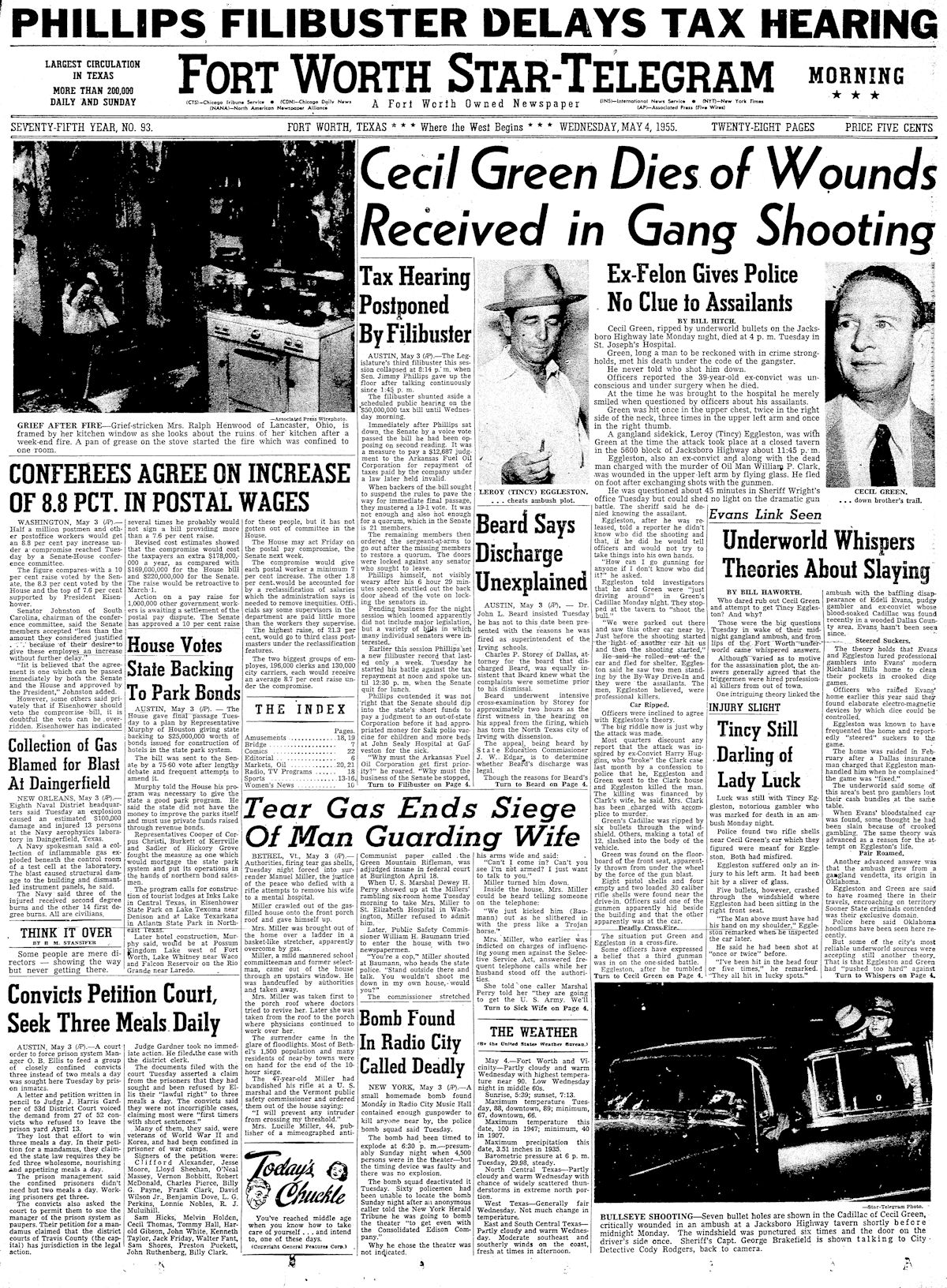 Ann Arnold in Gamblers & Gangsters writes that suspicion centered on Norris for two reasons: His sister Dorothy owned the By-Way Inn, and police believed that Green and Norris, who had partnered in a series of robberies, had fallen out over the division of revenue.
Ann Arnold in Gamblers & Gangsters writes that suspicion centered on Norris for two reasons: His sister Dorothy owned the By-Way Inn, and police believed that Green and Norris, who had partnered in a series of robberies, had fallen out over the division of revenue.
Soon after Green’s death his wife, Rita, moved in with Norris.
In August Tincy, still free on bond in the Clark case, left home, telling his wife he was going to meet someone, possibly another extortion victim. Police theorized that instead of one person, two persons met Tincy, and one of them killed him. The next day, acting on an anonymous tip, police found Eggleston’s blood-smeared Oldsmobile in the parking lot of a Buddie’s grocery store on North Main Street.
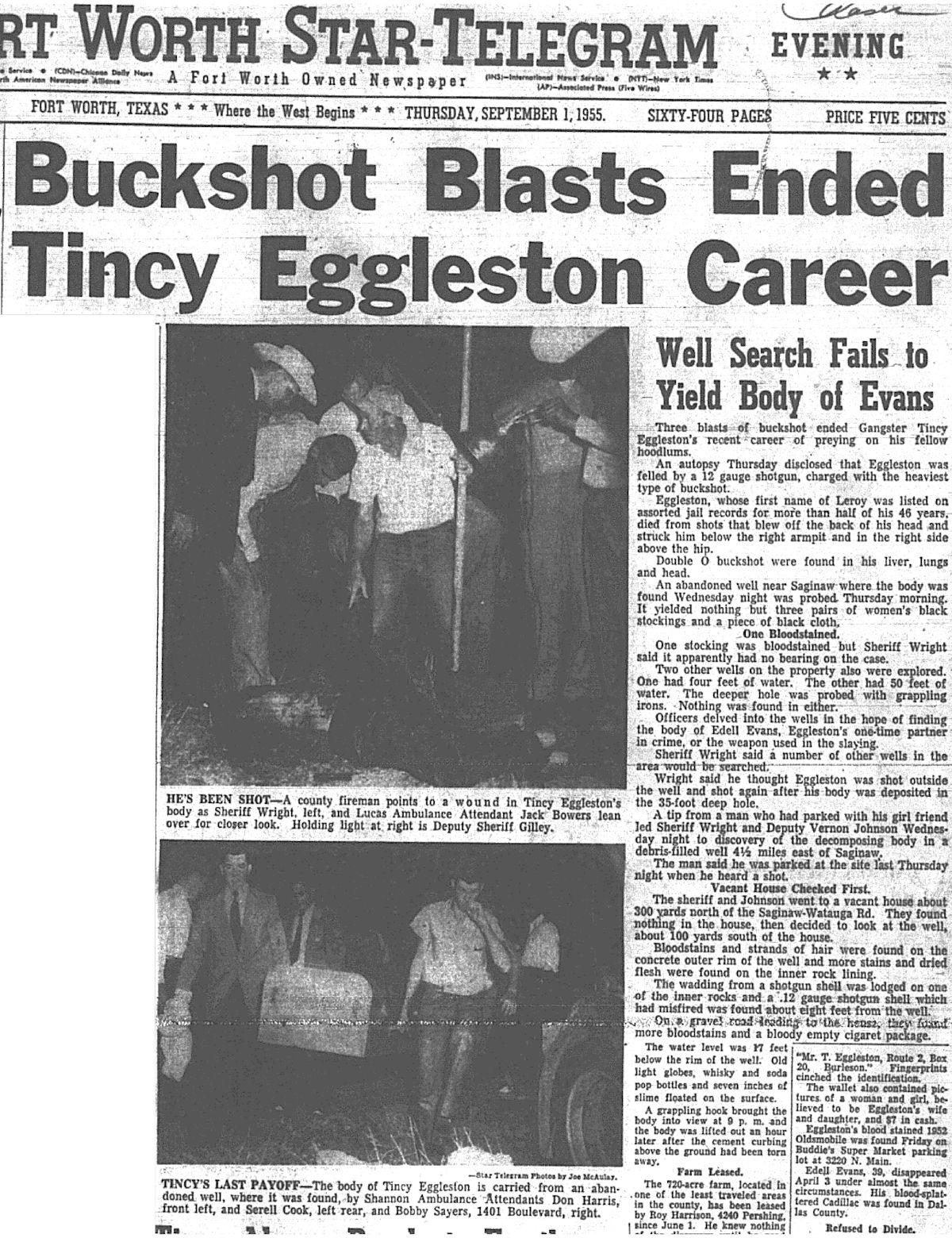 On August 31 Eggleston’s shotgunned body was found in an abandoned well east of Jacksboro Highway.
On August 31 Eggleston’s shotgunned body was found in an abandoned well east of Jacksboro Highway.
1956
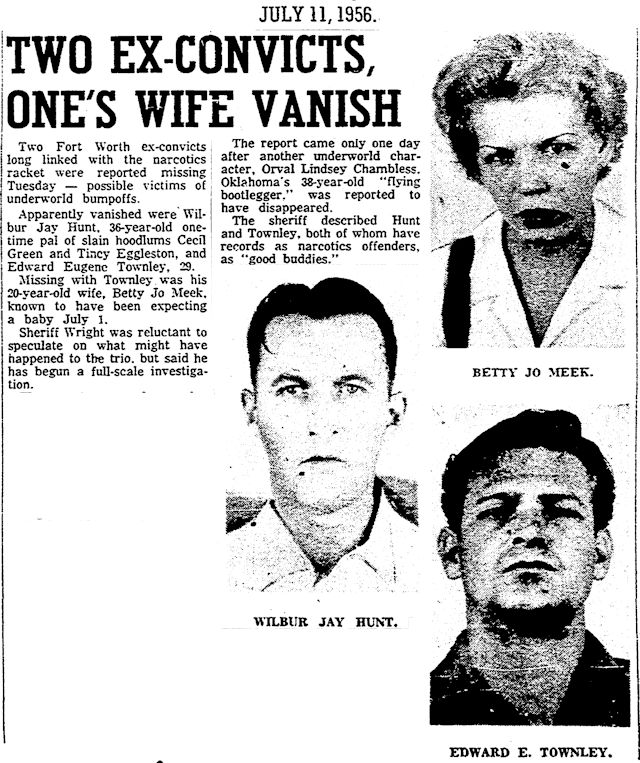 In July 1956 narcotics dealer Edward Eugene Townley and wife Betty Jo Meek, who was eight months pregnant, disappeared from an Eagle Mountain Lake trailer camp and were never seen again. Townley’s Cadillac was left behind. Norris was a prime suspect. Note that Orville Lindsay Chambless was reported missing the previous day.
In July 1956 narcotics dealer Edward Eugene Townley and wife Betty Jo Meek, who was eight months pregnant, disappeared from an Eagle Mountain Lake trailer camp and were never seen again. Townley’s Cadillac was left behind. Norris was a prime suspect. Note that Orville Lindsay Chambless was reported missing the previous day.
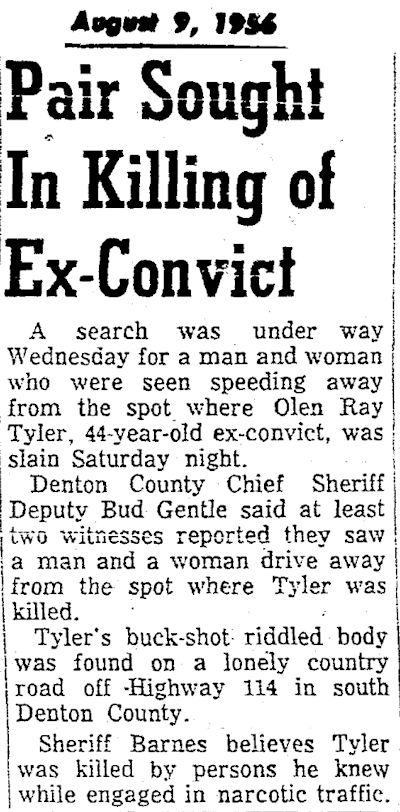 In August narcotics dealer Olen Ray Tyler was shotgunned to death on a lonely road in Denton County. A man and woman were seen speeding away from the scene. Police suspected that the man was Norris.
In August narcotics dealer Olen Ray Tyler was shotgunned to death on a lonely road in Denton County. A man and woman were seen speeding away from the scene. Police suspected that the man was Norris.
Also in August, Charles Cates, who ran a gambling house two blocks west of Jacksboro Highway, was counting his money when the telephone rang. Cates picked up the receiver, and the house exploded.
Under the house police found wires that ran to Jacksboro Highway. Police suspected that one man had phoned Cates from a telephone booth on the highway and that another man in a car nearby had detonated the bomb when signaled by the first man.
Cates survived.
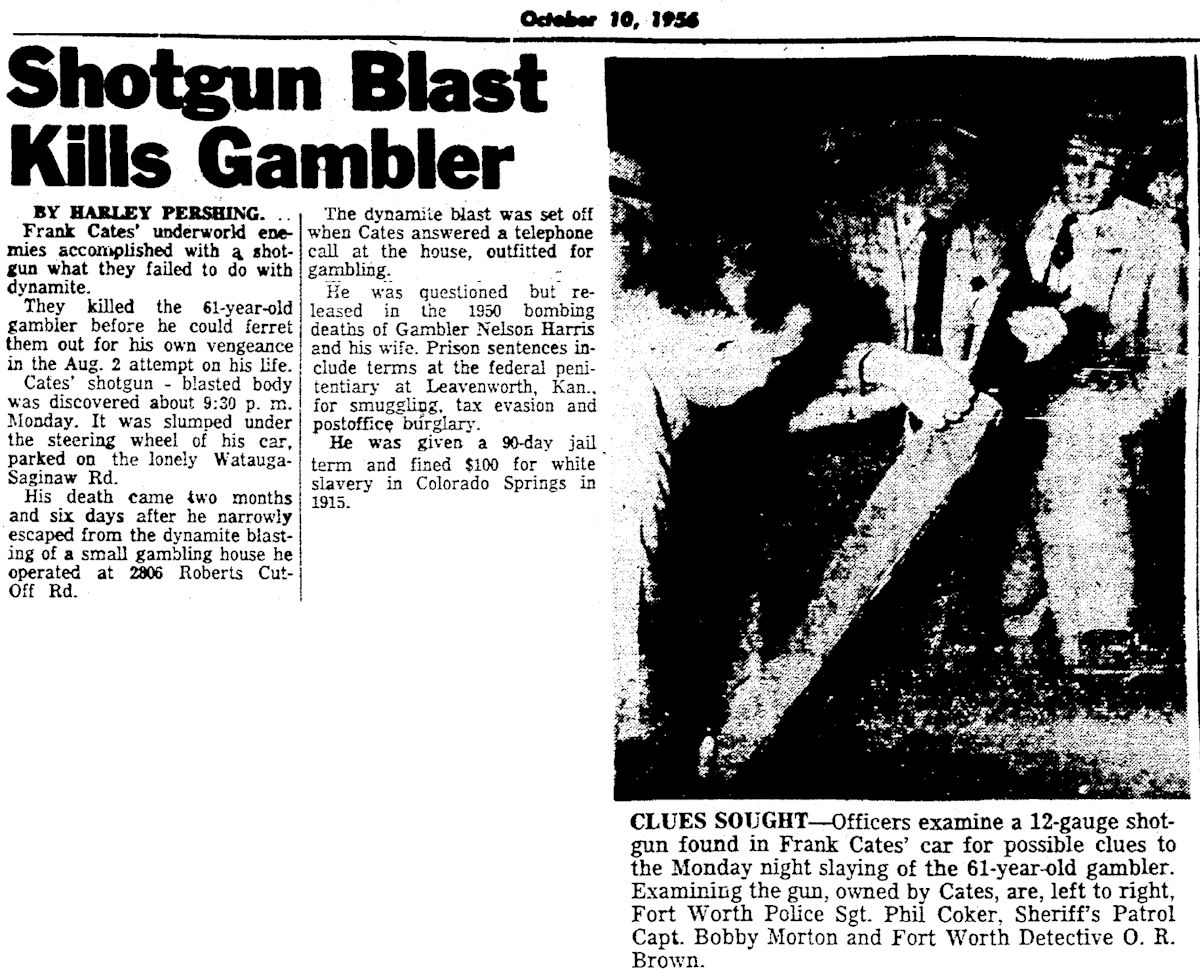 A few weeks later Gene Paul Norris telephoned Cates at least twice. Soon after, Cates was found shotgunned to death in his car. The car was parked within a mile of the well that had yielded the body of Tincy Eggleston.
A few weeks later Gene Paul Norris telephoned Cates at least twice. Soon after, Cates was found shotgunned to death in his car. The car was parked within a mile of the well that had yielded the body of Tincy Eggleston.
Ann Arnold in Gamblers & Gangsters writes that Norris may have killed Cates because Norris suspected that Cates—in order to eliminate the competition from Norris’s gambling activity in the back of Howard Dodd’s tavern on Jacksboro Highway—had informed Texas Rangers about Norris’s gambling.
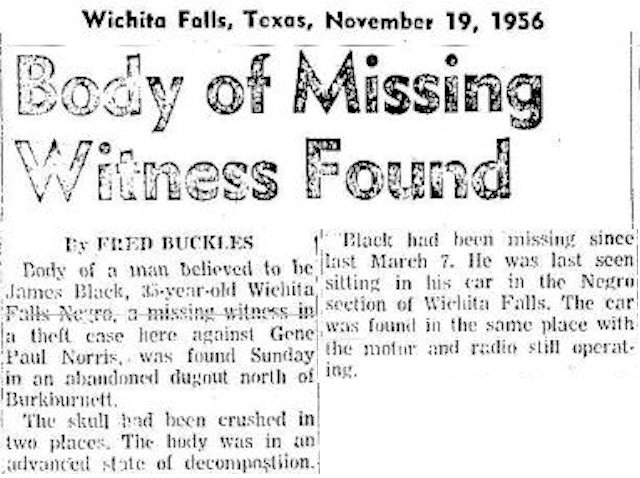 Also in 1956 Norris pulled off a small con. He telephoned a Wichita Falls oilfield supply company, said he represented an oil company in Oklahoma City, and wanted to buy $5,000 worth of equipment. He would pick up the equipment in his company’s truck. But he later telephoned and said that the company truck had broken down and that he would instead pick up the equipment in a rented truck. The rental company assigned an employee, James Black, to drive the truck with Norris as passenger. After Norris got the equipment he transferred it from the rented truck to his own truck and bid his adieu. After the oil field supply company billed the Oklahoma City company for the equipment that its “representative” had bought, it realized it had been swindled. Norris was arrested and brought to Wichita Falls to stand trial. Driver Black identified Norris as the man who took the equipment. Just before Norris was to stand trial and was free on bond, Black disappeared. His body was later found in a storm cellar, his skull crushed.
Also in 1956 Norris pulled off a small con. He telephoned a Wichita Falls oilfield supply company, said he represented an oil company in Oklahoma City, and wanted to buy $5,000 worth of equipment. He would pick up the equipment in his company’s truck. But he later telephoned and said that the company truck had broken down and that he would instead pick up the equipment in a rented truck. The rental company assigned an employee, James Black, to drive the truck with Norris as passenger. After Norris got the equipment he transferred it from the rented truck to his own truck and bid his adieu. After the oil field supply company billed the Oklahoma City company for the equipment that its “representative” had bought, it realized it had been swindled. Norris was arrested and brought to Wichita Falls to stand trial. Driver Black identified Norris as the man who took the equipment. Just before Norris was to stand trial and was free on bond, Black disappeared. His body was later found in a storm cellar, his skull crushed.
1957
James Edward Papworth, who had only a minor criminal record, while in prison had met a bank embezzler. But John Wesley Taylor had not embezzled from just any bank. While manager of Fort Worth National Bank’s branch at Carswell Air Force Base he had embezzled $7,300 from the bank to cover gambling losses.
That gave Papworth an idea.
Papworth began mining Taylor’s detailed knowledge of the air base and the branch bank: ways in, ways out, guards, alarms, the safe, the best times to strike.
Taylor provided Papworth with a floorplan of the branch bank, said the bank was at its ripest on payroll day: $500,000 ($4.5 million today).
After the two men were released from prison, plotting moved from abstracts to tangibles.
But the actual execution of such a robbery, Papworth knew, called for someone more audacious than he.
Enter Gene Paul Norris.
Papworth asked another ex-con, James Walter McFarland Jr., to introduce him to Norris, whom Papworth knew only by reputation.
McFarland introduced Papworth to Norris at the Beachcomber bar on Jacksboro Highway. Papworth told Norris about his plan. Norris was all in. One theory is that Norris needed money to try once again to get his brother Pete out of prison.
Gene Paul Norris then recruited a fifth ex-con, William Carl Humphrey, who sometimes served as Norris’s bodyguard.
McFarland was to receive 10 percent of the robbery money for introducing Papworth to Norris. The remaining 90 percent of the money would be split by Norris, Humphrey, Papworth, and Taylor.
How did Norris plan to gain access to a high-security bank in a high-security Air Force base? Papworth later told investigators that Norris planned to kidnap a Carswell branch bank teller, Mrs. Elizabeth Barles, and her twelve-year-old son, Jean Jolley. They lived on Meandering Road between Carswell and Jacksboro Highway. Papworth said Norris planned to force Mrs. Barles to give him her key to the bank and the key to her car. Papworth said Norris planned to kill Mrs. Barles and then get past security guards at the east gate of Carswell by wearing Mrs. Barles’s clothing (“if her clothes fit him”) and impersonating her as he drove her car, with its base access sticker.
Taylor had known Mrs. Barles when he worked at the bank. She was a friend. When Taylor learned that she was to be killed, Taylor tried to protect her by claiming she was his girlfriend.
After Taylor saw that the other four men were “serious” about the robbery, he contacted the FBI about the plot. The FBI was interested: By 1957 Gene Paul Norris, just as his big brother had been in 1942, was on the FBI’s Ten Most Wanted List.
Taylor agreed to serve as informant.
Then Papworth got cold feet. He later testified that he had tried to get out of the robbery but that Norris threatened to harm him and his wife and child.
Police Chief Cato Hightower also later testified that Norris planned to kill the branch bank’s current manager and shoot his way out if necessary.
Papworth, Norris, and Humphrey had scheduled the robbery for April 30. On April 29 the trio was making a practice run of the robbery route from the Barles home on Meandering Road to the Air Force base. Papworth got cold feet, and Norris ditched him, going on with Humphrey. But on Meandering Road they realized they were being followed by a police car. Norris and Humphrey turned around and headed for Jacksboro Highway.
Two other police cars joined the lead police car as Norris and Humphrey raced toward Jacksboro Highway.
Norris and Humphrey began firing at the pursuing police cars soon after reaching the highway.
Police and Texas Rangers in the lead car returned the gunfire. Tarrant County Sheriff Harlon Wright and Chief Hightower participated in the chase.
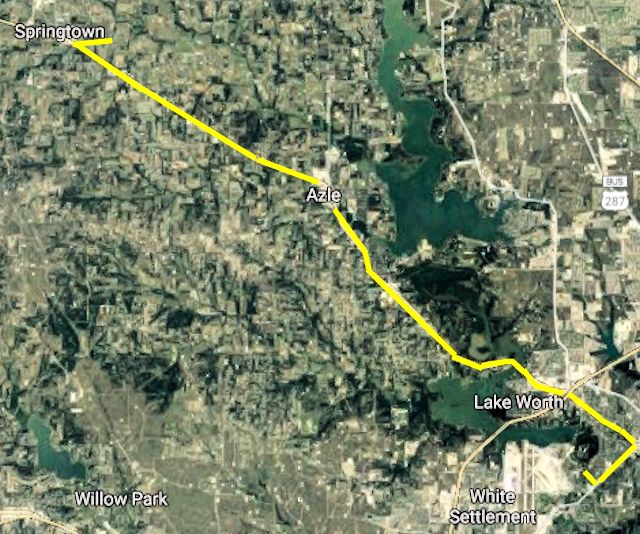 The five cars sped, sometimes in excess of one hundred miles an hour, up Jacksboro Highway through Sansom Park . . . across the Lake Worth bridge . . . Azle . . . La Junta.
The five cars sped, sometimes in excess of one hundred miles an hour, up Jacksboro Highway through Sansom Park . . . across the Lake Worth bridge . . . Azle . . . La Junta.
After more than twenty miles, at Springtown Norris and Humphrey turned onto a county road and headed east. Near Walnut Creek they lost control of the car at a sharp curve and crashed.
Norris and Humphrey abandoned their wrecked car and ran toward the creek.
Seconds later the police cars arrived. As Norris and Humphrey ran into the creek, they shot at the lawmen, Norris with a shotgun, Humphrey with a pistol.
But they were outgunned.
Walnut Creek became their River Styx: Humphrey was shot twenty-three times, Norris twenty-eight.
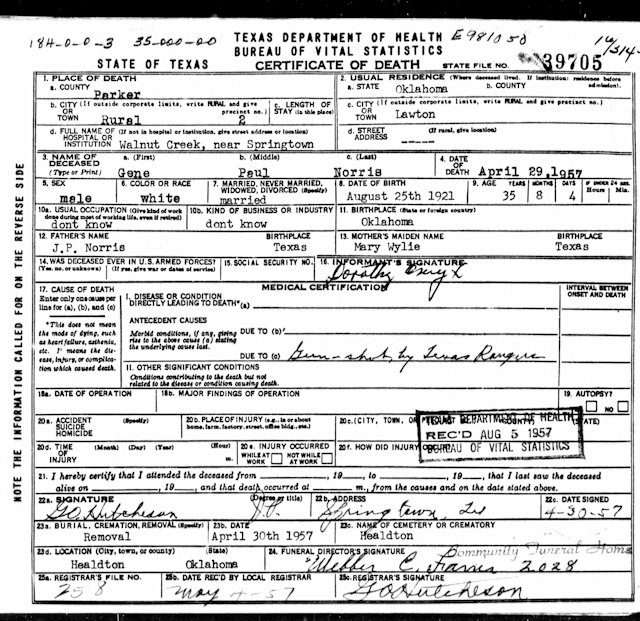
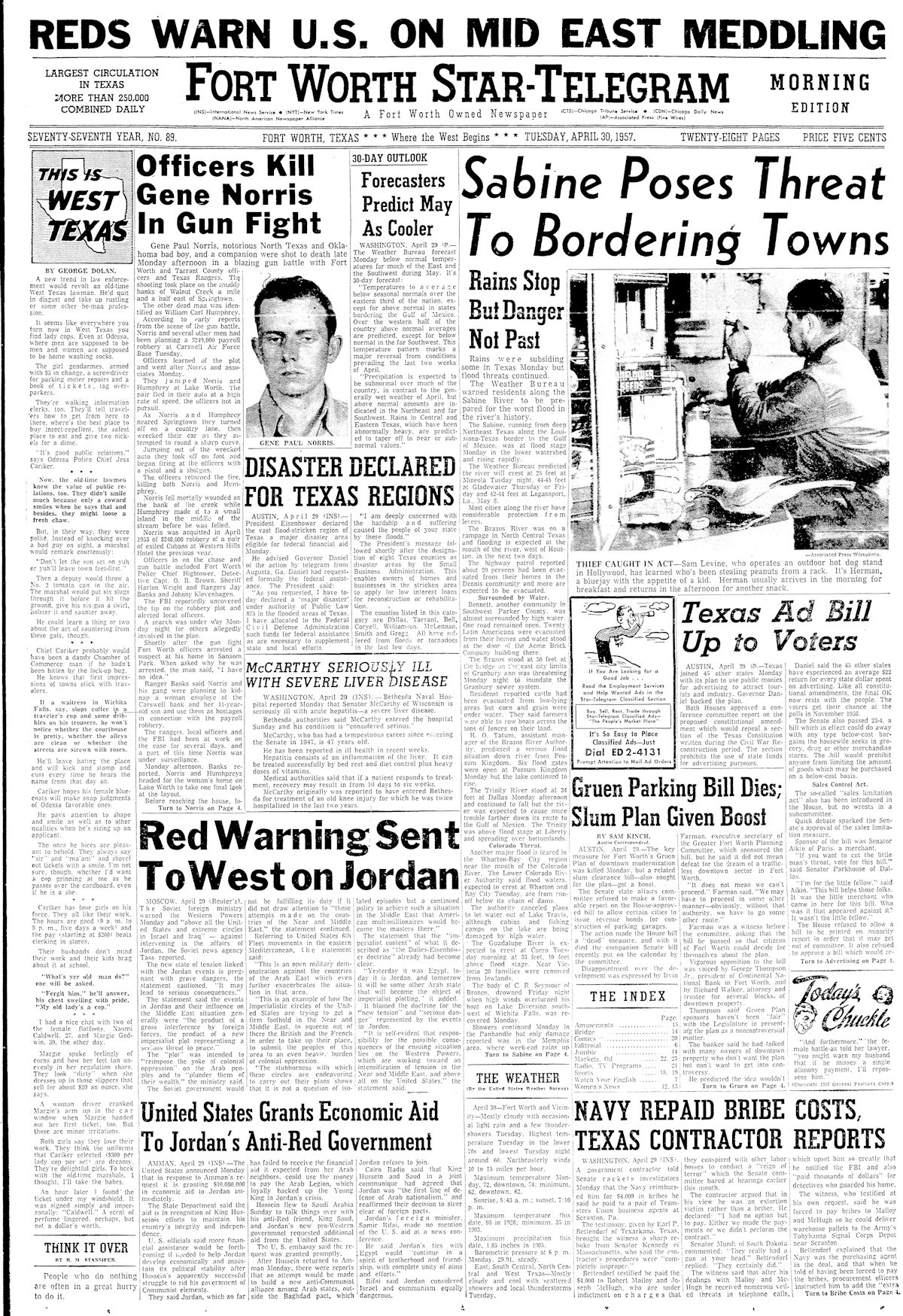 Reaction to the death of Gene Paul Norris fell along a wide spectrum.
Reaction to the death of Gene Paul Norris fell along a wide spectrum.
“He was a good boy,” said Norris’s mother Mary.
Gene Paul was “our pride and joy,” said big brother Pete, by then forty-five and in prison twenty years. “The whole family went to every extreme to see that Paul would have a legitimate life.”
Norris was a “madman,” said Police Chief Cato Hightower.
“The no. 1 badman of the Southwest,” said Judge Willis McGregor.
Pete Norris rejected the theory that his brother wanted to rob the Carswell bank to get enough money to break Pete out of prison—again.
When Gene Paul Norris was killed, Floyd Allen Hill was still in Huntsville prison for the Cuban caper, which police said was masterminded by Norris and Hill. Responding to the death of Norris, Hill told a reporter, “I know the boy was in a position where he didn’t have to do what they said he was doing.”
Was Hill cryptically suggesting that Norris had retained his share of the Cuban caper money?
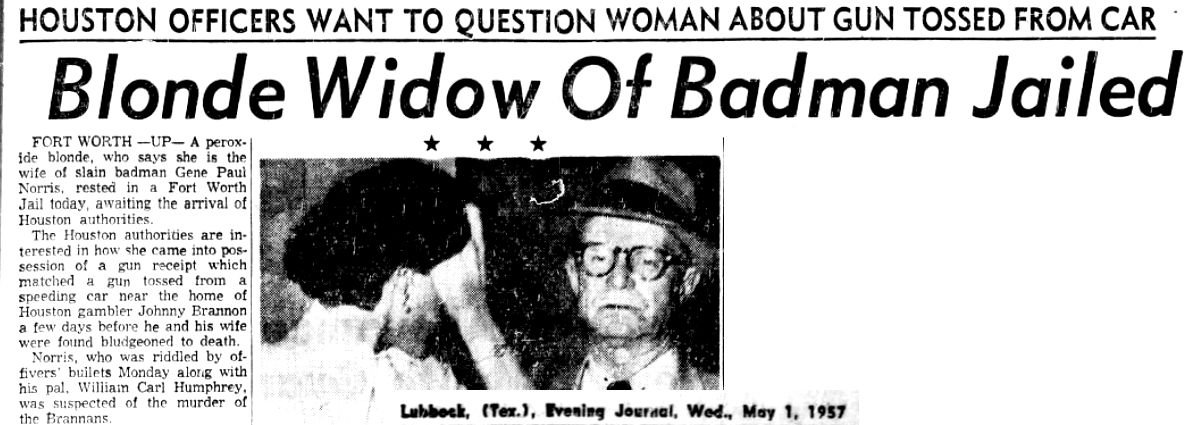 Wichita County Sheriff Weldon Bailey said, “When a guy like Norris gets killed, it gives us a chance to clear our books on a lot of unsolved killings.”
Wichita County Sheriff Weldon Bailey said, “When a guy like Norris gets killed, it gives us a chance to clear our books on a lot of unsolved killings.”
For example, in May police jailed Rita Green Norris for questioning. She was found in possession of a gun receipt that matched a gun that was tossed from a car that police chased near the home of Houston gambler Johnny Brannon and wife. The car matched the description of Norris’s car. A few days later, on April 16, the Brannons were bludgeoned to death. Police theorized that Norris killed the couple because Brannon’s testimony had helped send Pete Norris to prison for murder in 1937.
That’s a twenty-year grudge.
Some Fort Worth investigators theorized that on April 29, when Norris realized that police were following him and Humphrey on Meandering Road, he had risked the high-speed chase rather than be apprehended and stand trial for the murder of the Brannons.
 In November the body of bootlegger Orville Lindsay Chambless was found in a shallow grave in Oklahoma. Chambless had last been seen in July 1956. Investigators theorized that Norris had killed Chambless because Chambless had implicated Norris in the Cuban caper.
In November the body of bootlegger Orville Lindsay Chambless was found in a shallow grave in Oklahoma. Chambless had last been seen in July 1956. Investigators theorized that Norris had killed Chambless because Chambless had implicated Norris in the Cuban caper.
Police estimated the number of murders committed by Gene Paul Norris as low as ten and as high as forty.
Chief Hightower said Norris committed nine of the ten cases of murder or disappearance listed here. Oklahoma police said Norris was the killer of the tenth: Orville Lindsay Chambless.
One lawman estimated that Norris killed more people than John Dillinger and Clyde Barrow combined but was never convicted.
 Gene Paul Norris, “madman” and “our pride and joy,” is buried in Carter County, Oklahoma.
Gene Paul Norris, “madman” and “our pride and joy,” is buried in Carter County, Oklahoma.
 Postscript 1: James Edward Papworth, the mastermind of the Carswell robbery plan, was convicted of conspiracy to rob the bank.
Postscript 1: James Edward Papworth, the mastermind of the Carswell robbery plan, was convicted of conspiracy to rob the bank.
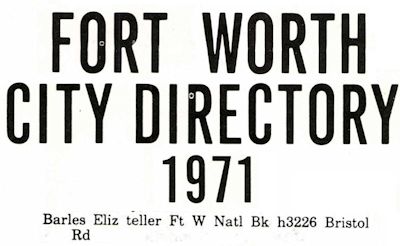 Postscript 2: Mrs. Elizabeth Barles was one of the few people who escaped the dark intent of Gene Paul Norris. She lived to work as a teller for Fort Worth National Bank for many more years.
Postscript 2: Mrs. Elizabeth Barles was one of the few people who escaped the dark intent of Gene Paul Norris. She lived to work as a teller for Fort Worth National Bank for many more years.
Postscript 3: Pete Norris, sentenced to 436 years in prison in 1943, was released in 1960 to work in the east Texas oilfields. He died in 1974.






Pingback: Texas Ranger Pistol Pair Nods to RIAC’s Bedford Expansion - Real Guns People